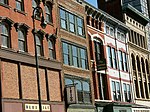Knights of Columbus Building (New Haven, Connecticut)

The Knights of Columbus Building, in Downtown New Haven, Connecticut, is the headquarters of the Roman Catholic fraternal service organization, the Knights of Columbus. Also known as the Knights of Columbus Tower or The Knights' Tower, the building was designed by Kevin Roche John Dinkeloo and Associates and finished in 1969. This 23-story modern style reinforced concrete building, at 320 feet (98 meters) tall, is the third-tallest building in the city's skyline. The Knights' Tower serves as the international headquarters for the Knights of Columbus and is home to the Supreme Council. Led by the Supreme Knight, the chief executive officer of the Knights, the building provides administrative support and leadership for more than 15,000 councils worldwide. The cylindrical towers at the corners give the structure a simple geometric form and represent the four core principles of the Order: Charity, Unity, Fraternity, and Patriotism.The building was built at 1 Columbus Plaza next to the New Haven Coliseum (razed in 2007), which was designed by the same firm.
Excerpt from the Wikipedia article Knights of Columbus Building (New Haven, Connecticut) (License: CC BY-SA 3.0, Authors, Images).Knights of Columbus Building (New Haven, Connecticut)
Church Street, New Haven
Geographical coordinates (GPS) Address External links Nearby Places Show on map
Geographical coordinates (GPS)
| Latitude | Longitude |
|---|---|
| N 41.3026 ° | E -72.9274 ° |
Address
Knights of Columbus Supreme Council
Church Street 1
06510 New Haven
Connecticut, United States
Open on Google Maps




